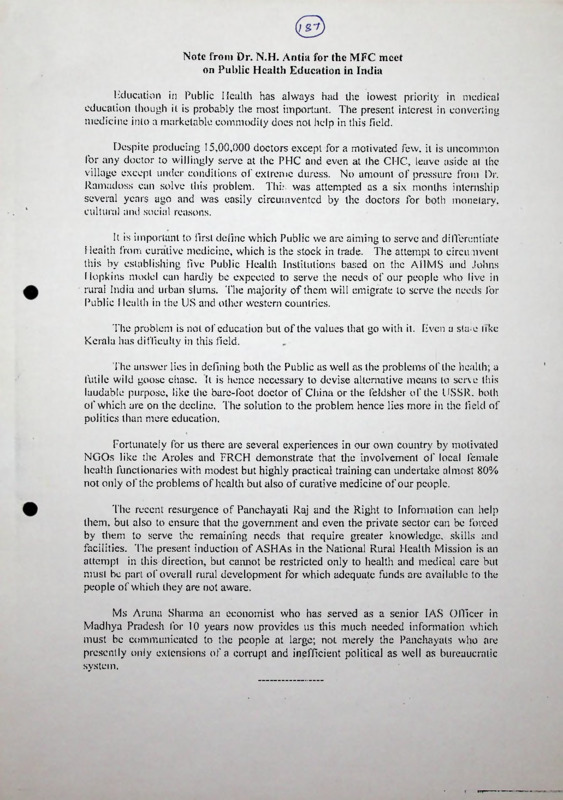Note from Dr. N.H. Antia for the MFC meet on Public Health Education in India
Item
- Title
- Note from Dr. N.H. Antia for the MFC meet on Public Health Education in India
- Creator
- N H Antia
- Date
- 2007
- extracted text
-
Note from Dr. N.H. Antia for the MFC meet
on Public Health Education in India
Education in Public Health has always had the lowest priority in medical
education though it is probably the most important. The present interest in converting
medicine into a marketable commodity docs not help in this field.
Despite producing 15,00,000 doctors except for a motivated few. it is uncommon
for any doctor to willingly serve at the PHC and even at the CHC, leave aside at the
village except under conditions of extreme duress. No amount of pressure from Dr.
Ramadoss can solve this problem. This was attempted as a six months internship
several years ago and was easily circumvented by the doctors for both monetary,
cultural and social reasons.
It is important to first define which Public we arc aiming to serve and differentiate
I lealth from curative medicine, which is the stock in trade. The attempt to circumvent
this by establishing five Public Health Institutions based on the AIIMS and Johns
Hopkins model can hardly be expected to serve the needs of our people who live in
rural India and urban slums. The majority of them will emigrate to serve the needs for
Public Health in the US and other western countries.
The problem is not ofcducation but of the values that go with it. Even a sta.e like
Kerala has difficulty in this field.
The answer lies in defining both the Public as well as the problems of the health; a
futile wild goose chase. It is hence necessary to devise alternative means to serve this
laudable purpose, like the bare-foot doctor of China or the feldsher of the USSR, both
of which are on the decline. The solution to the problem hence lies more in the Held of
politics than mere education.
Fortunately for us there are several experiences in our own country by motivated
NGOs like the Aroles and FRCH demonstrate that the involvement of local female
health functionaries with modest but highly practical training can undertake almost 80%
not only of the problems of health but also of curative medicine of our people.
The recent resurgence of Panehayati Raj and the Right to Information can help
them, but also to ensure that the government and even the private sector can be forced
by them to serve the remaining needs that require greater knowledge, skills and
facilities. The present induction of ASHAs in the National Rural Health Mission is an
attempt in this direction, but cannot be restricted only to health and medical care but
must be part of overall rural development for which adequate funds are available to the
people of which they are not aware.
Ms Aruna Sharma an economist who has served as a senior IAS Officer in
Madhya Pradesh for 10 years now provides us this much needed information which
must be communicated to the people at large; not merely the Panchayats who are
presently only extensions of a corrupt and inefficient political as well as bureaucratic
system.
Position: 2931 (3 views)

